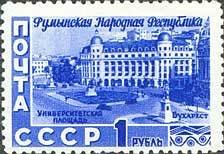Stamp: University Square in Bucharest (Soviet Union, USSR 1952)
University Square in Bucharest (Soviet Union, USSR 1952)
26 July (Soviet Union, USSR ) within release Death Centenary of Vasily Zhukovsky goes into circulation Stamp University Square in Bucharest face value 1 Russian ruble
| Stamp University Square in Bucharest in catalogues | |
|---|---|
| Michel: | Mi:SU 1637 |
Stamp is vertical format.
Also in the issue Death Centenary of Vasily Zhukovsky:
- Stamp - University Square in Bucharest face value 1;
- Stamp - Vasily A. Zhukovsky (1783-1852), Russian poet face value 40;
Stamp University Square in Bucharest it reflects the thematic directions:
A monument is a type of structure that was explicitly created to commemorate a person or event, or which has become relevant to a social group as a part of their remembrance of historic times or cultural heritage, due to its artistic, historical, political, technical or architectural importance. Examples of monuments include statues, (war) memorials, historical buildings, archaeological sites, and cultural assets. If there is a public interest in its preservation, a monument can for example be listed as a UNESCO World Heritage Site. The Palgrave Encyclopedia of Cultural Heritage and Conflict gives the next definition of monument:
Architecture (Latin architectura, from the Greek ἀρχιτέκτων arkhitekton "architect", from ἀρχι- "chief" and τέκτων "builder") is both the process and the product of planning, designing, and constructing buildings and other physical structures. Architectural works, in the material form of buildings, are often perceived as cultural symbols and as works of art. Historical civilizations are often identified with their surviving architectural achievements.
A building or edifice is a structure with a roof and walls standing more or less permanently in one place, such as a house or factory. Buildings come in a variety of sizes, shapes and functions, and have been adapted throughout history for a wide number of factors, from building materials available, to weather conditions, to land prices, ground conditions, specific uses and aesthetic reasons. Buildings serve several needs of society – primarily as shelter from weather, security, living space, privacy, to store belongings, and to comfortably live and work. A building as a shelter represents a physical division of the human habitat (a place of comfort and safety) and the outside (a place that at times may be harsh and harmful).
A town square (or public square, urban square, city square or simply square), also called a plaza or piazza, is an open public space commonly found in the heart of a traditional town or city, and which is used for community gatherings. Related concepts are the civic center, the market square and the village green.
In the visual arts, a cityscape (urban landscape) is an artistic representation, such as a painting, drawing, print or photograph, of the physical aspects of a city or urban area. It is the urban equivalent of a landscape. Townscape is roughly synonymous with cityscape, though it implies the same difference in urban size and density (and even modernity) implicit in the difference between the words city and town. In urban design the terms refer to the configuration of built forms and interstitial space.



